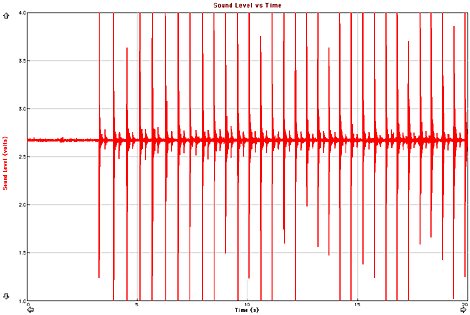With the advent of computers for data gathering in the classroom,
the emphasis has shifted somewhat from the traditional model of filling
the hours with tedious, repetitive data collection - such as we used to
do by measuring dot positions on a piece of spark tape - only to
conclude with a graph and a couple of questions near the end.
Data collection is often nearly instantaneous, or at least in
real-time, and the bulk of the time needed to complete a lab report can
be spent reflecting on what the activity actually is about rather than
simply waiting to take the next data point.
A few days ago I had a case in point with Vernier's lab system for measuring the
speed of sound. As I've mentioned several times before in this column,
Vernier is the low-end Mac enthusiast's best friend. They continue to
offer equipment compatible with every Mac ever made, including the Plus. Even better, they still
offer the software and equipment needed to make those old Apple II
computers perfectly legitimate lab data collection instruments.
If you're looking for a use for one of those old computers, consider
equipping it with a Vernier serial port interface and a microphone.
Vernier's software - which runs on Power Macs, 680x0 machines, and has
just recently been adapted for OS X - will measure the pressure
waves of a sound passing over a microphone and graph the result.
One of the labs in their manual goes like this: Put the microphone
near the end of a long tube. Any time sound goes into a larger or
smaller region, such as when it exits the tube, part of the sound will
reflect. If you make a sharp sound such as snapping your fingers near
the microphone, the computer can measure the initial sound plus several
echoes. The entire experiment is over by the time you straighten your
fingers. In fact, the data gathering portion of this lab lasts
approximately 0.003 seconds, or three milliseconds.

Can you tell how far the students were standing from the wall based on
this recording of the sound of them tapping a hammer and the resulting
echo from the wall?
With such technology available, I am able to tell my students (I
swear I am not making this up), "Use this equipment to figure out the
speed of sound. Report the value you get and write a paragraph about
how you did it."
I don't tell them to measure the length of the tube or divide the
length by the time measured by the sensor; they figured it out on their
own from the context of the earlier discussion on sonar. A few had to
be nudged to double the tube length because the sound echo makes a
round trip; other than that, we got excellent data, the students
learned how sonar works and what speed of light is, and we could spend
several minutes just debriefing on the technique involved.
This model of student-generated methodology is considered
high-powered stuff in science education and is much more memorable than
a carefully written, step by step procedure that tells everything from
how to hold the mike to which button to press and when. Vernier's own
lab manuals are written in this excruciating detail - good for
beginning teachers and students, but really overkill when you consider
it takes several pages of button pushing instructions to get to the 3
millisecond measurement.
Many physics teachers already know the benefits of computer or
calculator - or Palm-based data collection. I'm trying to encourage the
rest of our staff to do one computer-based lab a semester, but it isn't
easy. In general, my colleagues are not as comfortable with computers
as I am, and despite several (maybe six?) workshops I have conducted
for them, the most frequent request I get is, "When are we going to be
trained on this?"
Anyway, if you're a physical science, general science, chemistry, or
even a biology (especially physiology) teacher, give Vernier and their
competitor, Pasco, a look. See if
you can begin a gentle introduction into the world of computer-assisted
data collection. You won't be disappointed.
P.S. There are several shareware programs available for turning your
Mac's microphone into an oscilloscope probe and displaying your
voiceprint on the computer in real time. I use one called Digital
Oscilloscope. If your budget's tight, you can do a surprising
number of measurements with this software.
is a longtime Mac user. He was using digital sensors on Apple II computers in the 1980's and has networked computers in his classroom since before the internet existed. In 2006 he was selected at the California Computer Using Educator's teacher of the year. His students have used NASA space probes and regularly participate in piloting new materials for NASA. He is the author of two books and numerous articles and scientific papers. He currently teaches astronomy and physics in California, where he lives with his twin sons, Jony and Ben.< And there's still a Mac G3 in his classroom which finds occasional use.



